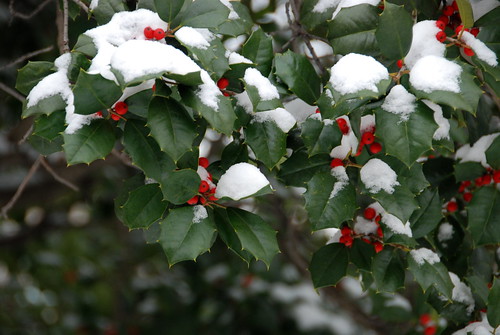 Decking the halls with boughs of holly is a tradition that pre-dates Christmas by quite a while. Romans used holly as a decoration and a gift for Saturnalia, a festival that took place around the winter solstice. Similarly, the Celts would place boughs around their house in the winter for protection and good luck. These traditions were absorbed by the Christian church, and holly became a common Christmas decoration.
Decking the halls with boughs of holly is a tradition that pre-dates Christmas by quite a while. Romans used holly as a decoration and a gift for Saturnalia, a festival that took place around the winter solstice. Similarly, the Celts would place boughs around their house in the winter for protection and good luck. These traditions were absorbed by the Christian church, and holly became a common Christmas decoration. Although decorating with holly started as a European tradition, hollies are native to North America as well. Many species are quite different from our classic idea of a holly tree -- some lose their leaves, some have black berries. But Ilex opaca, known as American holly, has the distinctive spiny, evergreen leaves and bright red berries that have been treasured as a winter decoration for millenia. Early colonists noticed them, too, and holly became an entrenched symbol of Christmas in North America.
 Holly berries are important food for birds, but poisonous to humans. Birds tend to wait a while into the winter before they start eating them -- repeated freezing and thawing can soften them up and make them more palatable. Meanwhile, we get to enjoy their decoration in the woods. The trees are dioecious -- meaning each tree is either male or female. At this time of year, if you spot a holly without berries, there could be several explanations: 1) it's a male; 2) it's a female without a male nearby; 3) its berries have been completely devoured relatively early in the season, or 4) it doesn't get enough light to set fruit.
Holly berries are important food for birds, but poisonous to humans. Birds tend to wait a while into the winter before they start eating them -- repeated freezing and thawing can soften them up and make them more palatable. Meanwhile, we get to enjoy their decoration in the woods. The trees are dioecious -- meaning each tree is either male or female. At this time of year, if you spot a holly without berries, there could be several explanations: 1) it's a male; 2) it's a female without a male nearby; 3) its berries have been completely devoured relatively early in the season, or 4) it doesn't get enough light to set fruit. In the wild: Ilex opaca is scattered throughout the woods of the Washington, DC region. They can grow up to 40 feet, but it's more common to see shorter trees. Now is a great time to spot them, because the evergreen leaves will stand out when other trees have lost their foliage.
In your yard: Holly is a great addition to a yard: for winter interest, habitat value, and as an evergreen screen. They prefer acidic soil. European and asian species are also sold in nurseries; ask for the native Ilex opaca. Compared to imported species, the native should have the most wildlife value -- although birds will eat the berries of most species, insects that have evolved relationships with the leaves of the native may not be able to survive off imports. And those insects serve as more bird food, throughout the year.
Like the photos in this post? Mouse over for credits; a click takes you to the photographer on Flickr.


